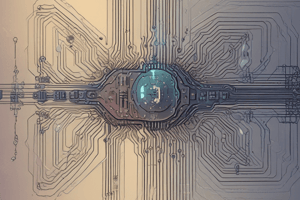Podcast
Questions and Answers
પાસા સમજેલ કે પાસા તેના ઓછે, તે આ ધરોવતું કેવું ક્ષેત્ર હોવો જોઈએ?
પાસા સમજેલ કે પાસા તેના ઓછે, તે આ ધરોવતું કેવું ક્ષેત્ર હોવો જોઈએ?
- ક્ષેત્ર-સમ
- પ્રદેશ-સમ
- વેગ-સમ
- ઊચી-સમ (correct)
Series connection માટે equivalent capacitance formula શું છે?
Series connection માટે equivalent capacitance formula શું છે?
- rac{C_1 + C_2}{C_1 * C_2}
- rac{C_1 * C_2}{C_1 + C_2} (correct)
- rac{C_1 + C_2}{C_1 - C_2}
- rac{C_1 - C_2}{C_1 * C_2}
Parallel connection માટે equivalent capacitance formula શું છે?
Parallel connection માટે equivalent capacitance formula શું છે?
- C1 + C2 + ... (correct)
- rac{C_1 * C_2}{C_1 + C_2}
- rac{C_1 + C_2}{C_1 * C_2}
- rac{C_1 - C_2}{C_1 * C_2}
Capacitor માં energy store થવું કેવુ ક્રિયा?
Capacitor માં energy store થવું કેવુ ક્રિયा?
Discharging capacitor નો time constant formula શું હોय?
Discharging capacitor નો time constant formula શું હોय?
Flashcards are hidden until you start studying
Study Notes
Capacitance in 12th-Grade Physics: Understanding Charged Storage
Capacitance, a fundamental concept in the realm of electric circuits, deals with the ability of a system to store an electric charge. In this chapter, we'll explore capacitance, its principles, and its applications, starting with the basics.
Charged Storage and Capacitors
Imagine a pair of conductive parallel plates separated by a non-conductive material like air or plastic. When these plates are connected to a battery, the negatively charged electrons flow from the battery to the positive plate, leaving the negative plate with an excess of positive electrons. This results in a buildup of electric charge on the negative plate, known as the capacitor's positive plate. A potential difference, or voltage, exists between the two plates, while the capacitor is charged.
Capacitance is the property of a capacitor that determines the amount of electric charge it can store at a given voltage. The capacitance value is typically given in farads (F), but in physics education, smaller units such as microfarads (µF) and nanofarads (nF) are commonly used.
Capacitance Formula
The capacitance of a parallel-plate capacitor, which is often the first capacitor you'll encounter, can be calculated using:
[ C = \frac{εA}{d} ]
where:
- (C) is the capacitance in farads
- (ε) is the dielectric constant of the material between the plates
- (A) is the area of the plates in square meters
- (d) is the distance between the plates in meters
Series and Parallel Connections
Capacitors can be connected in series or in parallel to create different types of circuits.
- Series connection: The equivalent capacitance in series is:
[ C_{eq} = \frac{C_1 * C_2}{C_1 + C_2} ]
- Parallel connection: The equivalent capacitance in parallel is:
[ C_{eq} = C_1 + C_2 + \ldots ]
Energy Storage in Capacitors
Capacitors store energy in the form of electric potential energy. The energy stored in a capacitor is given by:
[ W = \frac{1}{2}CV^2 ]
where:
- (W) is the energy in joules
- (C) is the capacitance in farads
- (V) is the voltage across the capacitor in volts
Discharging Capacitors
When a capacitor is discharged, the stored charge is released, and the voltage across the capacitor decreases. The time constant, (τ), of a discharging capacitor is given by:
[ τ = RC ]
where:
- (R) is the resistance in ohms
- (C) is the capacitance in farads
The voltage across the capacitor will decrease exponentially from its initial value to zero, following the relationship:
[ V(t) = V_0 * e^{-\frac{t}{τ}} ]
where (V(t)) is the voltage at time (t), and (V_0) is the initial voltage
As you move further into your 12th-grade physics course, you'll encounter concepts such as resonant circuits and AC circuits, where capacitors play a crucial role. Be prepared to learn more about these applications and the fundamentals behind them to further your understanding of this fascinating branch of physics.
Studying That Suits You
Use AI to generate personalized quizzes and flashcards to suit your learning preferences.




